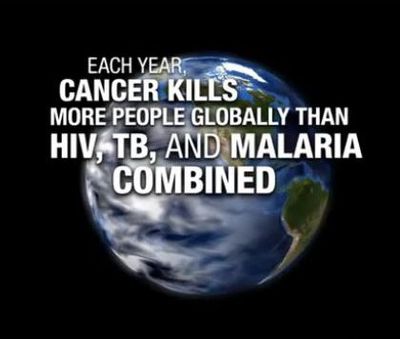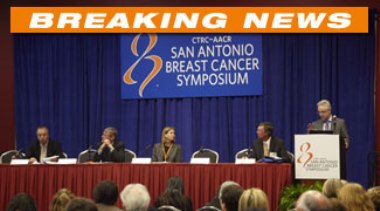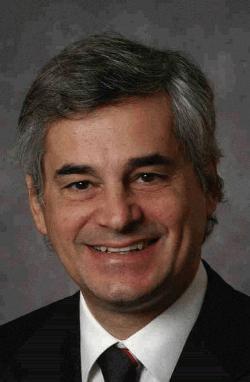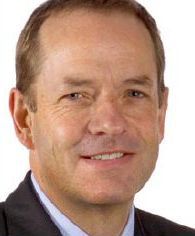 |
|
Courtesy of the American Association for Cancer Research / YouTube
|
| |
London, UK and Philadelphia, USA - December 10, 2010
Data from Tykerb investigational phase III studies in neo-adjuvant HER2-positive breast cancer presented at breast cancer symposium
Topline results were presented today from
two Phase III studies examining the effect of
Tykerb (lapatinib) in the neo-adjuvant setting of
HER2-positive breast cancer.
The combination of lapatinib and trastuzumab, with standard chemotherapy, was compared to standard chemotherapy plus either lapatinib or trastuzumab in a trial called
NeoALTTO.
 |
|
Courtesy of the American Association for Cancer Research / YouTube
|
| |
In another trial, known as
GeparQuinto, lapatinib plus standard chemotherapy was compared to trastuzumab plus standard chemotherapy.
The studies were conducted and presented by international cooperative groups, with research being funded in part by
GlaxoSmithKline.
Data findings from both trials were presented at the
33rd annual meeting of the
CTRC-AACR San Antonio Breast Cancer Symposium (SABCS), held in
San Antonio, Texas (8-12 December 2010).
 |
|
Each year, the CTRC-AACR San Antonio Breast Cancer Symposium attracts academic and private physicians and researchers, as well as other health care professionals focused on curing breast cancer, to discuss and learn about new and late-breaking research including experimental biology, etiology, prevention, diagnosis, and therapy of breast cancer and pre-malignant breast disease, as well as new findings from clinical trials.
Courtesy of the American Association for Cancer Research
|
| |
The primary endpoint for
NeoALTTO and
GeparQuinto was
pathological complete response (pCR) defined as the absence of invasive cancer cells in the breast at surgery.
 |
Paolo Paoletti, M.D., Head of Oncology Research and Development, GSK.
Photo: GSK |
| |
“In NeoALTTO, a higher level of complete pathological response was obtained by the dual inhibition of the HER2 pathway using an antibody, trastuzumab, and a small molecule tyrosine kinase inhibitor, lapatinib, compared with either agent alone. This is an important scientific finding,” said
Paolo Paoletti, M.D., Head of Oncology Research and Development, GSK.
“Although lapatinib is not currently approved in this setting, we are committed to further researching the potential of this combination in this aggressive form of breast cancer.”
NeoALTTO
The Neo-Adjuvant Lapatinib and/or Trastuzumab Treatment Optimisation Trial (NeoALTTO) randomised
455 patients with
HER2-positive primary breast cancer to receive
lapatinib (L) plus paclitaxel or
trastuzumab (T) plus paclitaxel or a combination of
lapatinib and trastuzumab (L+T) plus paclitaxel.
The study was led by the
Breast International Group (BIG) - in particular by its partners the
SOLTI cooperative group and the
Breast European Adjuvant Study Team (BrEAST) - and was funded by
GlaxoSmithKline.
The primary endpoint for
NeoALTTO was pathological complete response defined as the absence of invasive cancer cells in the breast at surgery or only non-invasive in-situ cancer in the breast.
Topline results showed the
pCR rate was 51.3 percent in the lapatinib plus trastuzumab combination arm compared to a rate of 24.7 percent for the lapatinib arm and 29.5 percent for the trastuzumab arm.
The difference in
pCR between the lapatinib plus trastuzumab arm compared to the trastuzumab arm was statistically significant, p=0.0001.
The
pCR difference between the lapatinib and trastuzumab arms was not statistically significant, p=0.34.
Grade 3 adverse events presented for
L,T and
L+T respectively were:
diarrhoea (23 percent, 2 percent and 21 percent),
neutropenia (16 percent, 3 percent and 9 percent),
hepatic (13 percent, 1 percent and 9 percent), and
skin disorders (7 percent, 3 percent, and 7 percent).
No deaths occurred during the treatment phase of the neo-adjuvant setting of the study, and no major cardiac dysfunction occurred during the neo-adjuvant phase of the study.
There was one patient death immediately after the end of treatment.
 |
| Courtesy of GlaxoSmithKline |
| |
Results presented at
SABCS 2010 reflect findings from the
18 weeks of therapy prior to surgery, a very important window in the treatment of early
breast cancer.
Analysis of primary endpoint efficacy and safety findings is ongoing.
The study is continuing for secondary endpoints, which include overall survival, disease-free survival and safety.
GeparQuinto
GeparQuinto is an open-label
Phase III trial led by the
German Breast Group which evaluated patients with
HER2-negative and
HER2-positive breast cancer.
In the
HER2-positive setting
620 patients were randomised to receive neo-adjuvant treatment with
epirubicin/cyclophosphamide followed by
docetaxel in combination with either
trastuzumab or
lapatinib.
The
lapatinib dosing used in the study was lower than the dose in the currently approved label for lapatinib.
The study employed pathological complete response as the primary endpoint defined as the absence of tumour residuals (invasive and non-invasive) in the breast and lymph nodes at the time of surgery.
Study results show that both the
lapatinib and
trastuzumab therapies demonstrated an ability to reduce the presence of tumour residuals in breast and nodes at the time of surgery.
The pCR rate in the
trastuzumab arm was 31.3 percent compared to the
lapatinib arm of 21.7 percent, p<0.03.
The topline presentation of the results at
SABCS contained limited safety data. Categories of frequently occurring serious adverse events, all grades, included: gastrointestinal, blood disorders and infections.
Analysis of primary endpoint efficacy and safety findings is ongoing.
The study is ongoing for secondary endpoints, which include overall survival, disease-free survival and safety.
About NeoALTTO
NeoALTTO is a multinational, randomised, Phase III study in primary breast cancer.
In the study,
455 patients with HER2 -positive primary breast cancer were randomised to one of three treatment arms; Patients were
randomised to receive either
lapatinib 1500 mg/d, or
trastuzumab four mg/kg IV loading dose followed by two mg/kg IV weekly, or lapatinib 1000 mg/d with
trastuzumab four mg/kg IV loading dose followed by two mg/kg IV weekly for a total of
six weeks.
 |
| Courtesy of GlaxoSmithKline |
| |
After this biological window, patients continued on the same targeted therapy plus weekly
paclitaxel 80 mg/m² for a further
12 weeks, until definitive surgery (total neo-adjuvant therapy duration of 18 weeks).
Paclitaxel was initiated at week four if there was evidence of disease progression at that time. In
NeoALTTO, the primary endpoint was
pCR defined as no invasive cancer in the breast or only non-invasive in-situ cancer in the breast specimen.
About GeparQuinto
GeparQuinto is a neo-adjuvant Phase III study, planned to include more than 2,500 patients that were HER2-positive and HER2-negative.
The HER2-positive cohort of the study included
620 HER2-positive breast cancer patients and compared lapatinib versus trastuzumab given concomitantly with anthracycline–taxane-based therapy.
Both groups received
trastuzumab post surgery.
The primary end point was pathological complete response defined as no invasive or non-invasive tumour residuals in breast and nodes, i.e. patients with some residual disease.
The trial was led and presented by the
GBG (German Breast Group) who are responsible for data management and the trial database.
The trial was supported by
GSK, Roche, Novartis and
Sanofi.
About Tykerb (lapatinib)
In the United States,
lapatinib is indicated in combination with
letrozole for the treatment of postmenopausal women with hormone receptor positive metastatic breast cancer that over expresses the
HER2 receptor for whom hormonal therapy is indicated.
Tykerb in combination with an aromatase inhibitor has not been compared to a
trastuzumab-containing chemotherapy regimen for the treatment of metastatic breast cancer.
Lapatinib is also
FDA approved in combination with
capecitabine for the treatment of patients with advanced or
metastatic breast cancer whose tumours over express
HER2 and who have received prior therapy including an
anthracycline, a
taxane, and
trastuzumab.3
In Europe, lapatinib, in combination with an
aromatase inhibitor (AI), is indicated for the treatment of post-menopausal women with
hormone receptor (HR)-positive, HER2 (ErbB2) over-expressing
metastatic breast cancer and for whom
chemotherapy is currently not intended.
In Europe, lapatinib is also approved in combination with
capecitabine for the treatment of patients with advanced or
metastatic breast cancer whose tumours over-express
HER2 and who have received prior therapy including an
anthracycline, a
taxane, and
trastuzumab.
Lapatinib is approved in 91 countries including the
U.S., Europe, Australia, India, Brazil, Russia, Turkey, South Korea and other countries around the world.
Registration dossiers have been filed in
Canada, China, Japan, Mexico and a number of countries in
Asia, Latin America and the
Middle East.
US FDA boxed warning and important safety information for Tykerb
Hepatotoxicity has been observed in clinical trials and postmarketing experience.
The hepatotoxicity may be severe and deaths have been reported.
Causality of the deaths is uncertain.
Patients with known severe hypersensitivity to
TYKERB or any of its components should not take
TYKERB.
Also, patients may experience decreased left ventricular ejection fraction, hepatotoxicity, diarrhoea, interstitial lung disease/pneumonitis,
QT prolongation, and risk of fetal harm in
pregnant women.
If
TYKERB is to be administered to patients with severe hepatic impairment, dose reduction should be considered.
The most common adverse reactions (≥20%) during therapy with
TYKERB plus letrozole compared to
letrozole were
diarrhoea (64%, 20%),
rash (44%, 13%),
nausea (31%, 21%), and
fatigue (20%, 17%).
The most common adverse reactions (>20%) during therapy with
TYKERB plus capecitabine versus
capecitabine alone were
diarrhoea (65%, 40%),
palmar-plantar erythrodysesthesia (53%, 51%),
nausea (44%, 43%),
rash (28%, 14%),
vomiting (26%, 21%), and
fatigue (23%, 25%).
About GlaxoSmithKline
GlaxoSmithKline – one of the world’s leading research-based pharmaceutical and healthcare companies – is committed to improving the quality of human life by enabling people to do more, feel better and live longer.
For further information please visit
www.gsk.com
GlaxoSmithKline enquiries:
UK Media enquiries:
David Mawdsley
(020) 8047 5502
Claire Brough
(020) 8047 5502
Stephen Rea
(020) 8047 5502
Alexandra Harrison
(020) 8047 5502
Jo Revill
(020) 8047 5502
European Analyst/Investor enquiries:
Sally Ferguson
(020) 8047 5543
Gary Davies
(020) 8047 5503
Ziba Shamsi
(020) 8047 3289
SOURCE:
http://www.gsk.com/media/
NOTE:
This release may not have been issued in every market in which GSK operates.
Research and develop
“The drugs discovered in the labs are not replacing the value of those medicines losing patent protection”
Andrew Witty, CEO of GlaxoSmithKline,
calls on the pharmaceutical industry to do more with less - and still be innovative
 |
|
Andrew Witty, CEO of GlaxoSmithKline
Photo: GlaxoSmithKline
|
| |
The past 50 years have seen the pharmaceutical industry deliver a constant flow of innovation.
This helped to increase life expectancy and reduce morbidity in very large population groups suffering from a wide variety of common and not-so-common diseases and illnesses.
The business model clearly worked - and up until 2001, ironically at about the time of the human-genome breakthroughs, most would have expected this trend to continue.
It has not. So now we are having to reinvent our industry.
It is an error to believe that the pharmaceutical industry is somehow not subject to market forces. It is. These forces simply operate over ultra-long cycles and are mitigated for periods of time by the existence of patents.
The power of these market forces is becoming clear as a number of factors come together.
The industry is witnessing increased competition from generic drugs as an unprecedented number of branded medicines lose patent protection.
This “patent cliff” has been estimated to be worth a staggering $200 billion over the period 2008-12.
Unfortunately, these losses have coincided with a decline in r&d productivity: the drugs discovered in the labs are not replacing the value of those medicines losing patent protection.
The reasons are complex.
The cyclical nature of scientific discovery has played its part, as has the industry’s misguided belief that it could “industrialise” the r&d process.
Decoding the human genome has also not yet led to the wave of new medicines originally hoped for.
In addition to these pressures, the industry faces a consolidation of purchasing power, via private-sector and governmental health-care reforms, putting unprecedented pressure on prices.
At the same time, regulatory standards, and caution, keep rising.
Hence the key question for 2011: how does the industry maintain long-term, high-risk investment in r&d against such a challenging backdrop?
As long as a gap remains between the number of medicines losing patent protection and the number of new medicines produced through r&d, it is clear that the size of the industry will continue to contract in the drive for efficiency.
For some players, more mergers and acquisitions are likely, but others will plan to shrink, and all parts of the value chain from r&d through to production and sales and marketing will be affected.
A critical dimension to determine success for the future will be getting r&d right.
In particular, we need to reverse the decline in productivity, improve success rates for regulatory approval and deliver medicines that add more than incrementally to a physician’s capabilities.
In the past the problem of r&d in big pharmaceutical companies has been “fixed” by spending more and by using scale to “industrialise” the research process.
These are no longer solutions: shareholders are not prepared to see more money invested in r&d without tangible success.
If anything, based on a rational allocation of capital, r&d should now be consuming less resource. Instead I believe the focus needs to be on two key issues.
Art, not just science
First, we need to recapture the ability to empower creative talent in the discovery phase of r&d by creating an environment in the labs that reflects the fact that discovering a drug is as much an art as it is a process.
But this needs to be combined with a more rigorous method for allocating resources only to where the prospects for success are greatest.
Second, we need to streamline the development phase, in part by ending earlier the development of drugs which do not offer the prospect of being truly distinctive.
In addition, I foresee more innovative partnerships emerging in r&d.
Pharmaceutical companies are increasingly partnering with smaller specialist firms and academia. This spreads risk with lower up-front costs.
There is also a need for big pharmaceutical firms to work together.
The decision of Pfizer and gsk to pool our hiv products to create ViiV Healthcare, a specialised hiv/aids company, is an example of this.
The industry in five years’ time will look very different from today.
Companies will need to put a premium on management and human capital, while operating in an increasingly complex social, legal, scientific and political environment.
As for governments, they will have to recognise the enormous industrial transformation that is under way and ensure that the incentive the industry needs - a fair reward for innovation - is not extinguished.
The pharmaceutical industry is hugely innovative.
But it now must apply that innovation to its own business model.
If governments work to support, not stifle, innovation, the industry will deliver the next era of revolutionary medicine.
http://www.gsk.com/media/downloads/economist-world-in-2011-gsk-witty.pdf
Andrew Witty
Chief Executive Officer of GlaxoSmithKline
 |
|
Andrew Witty
Photo: GlaxoSmithKline
|
| |
Andrew Witty assumed the position of Chief Executive Officer on 21 May 2008.
He is a member of the Board and Corporate Executive Team and previously held the role of President, Pharmaceuticals Europe.
Andrew joined Glaxo in 1985 and held a variety of roles in the UK business.
He was a Sales Representative for the Respiratory business, held a variety of Marketing roles and was Director of Pharmacy and Distribution.
He has worked in the Company’s International New Products groups, both in the Respiratory and HIV/Infectious disease fields and has been involved in multiple new product development programmes.
In 1993, Andrew was appointed Managing Director of Glaxo South Africa and later Area Director for GlaxoWellcome, South and East Africa.
Subsequently he moved to North Carolina as Vice President and General Manager, Marketing for GlaxoWellcome Inc., the group’s US subsidiary.
Andrew then moved to Singapore and led the Group’s operations in Asia as Senior Vice President, Asia Pacific prior to his appointment to the Corporate Executive Team as President of GSK Europe in 2003.
Andrew has served in numerous advisory roles to Governments around the world including South Africa, Singapore, Guangzhou China and the UK.
Andrew is President of the EFPIA, a position he took up on 1 January 2010.
Andrew has a Joint Honours BA in Economics from the University of Nottingham.
http://www.gsk.com/about/bio-witty-cet.htm
ASTROMAN magazine

